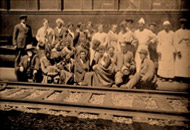City Directories and History: The Rectory, constructed ca. 1857, is a one-and-a-half story Gothic revival structure. Built of cypress, the walls of the Rectory are of board and batten construction. Facade is characterized by two dormers, one on each side of a projecting bay with portico. Portico has four built-up lattice columns. Entrance has transom and sidelights. Projecting bay with central window (6/6) consists of a pointed arch with freestanding eave decoration above the portico. Windows (4/4) flank portico on ground floor (double windows on facade as well as single within bay). Building has a gable roof with two interior chimneys (third chimney on roof in rear of house). Roof eave is broken at the two dormers trimmed in bargeboard. Bay windows are on both sides of the facade.
The Rectory is an example of Gothic revival architecture not usually seen in South Carolina. Similar in design to a structure in A.J. Downing’s Architecture of Country Houses, the Rectory illustrates the “Carpenters’ Gothic,” symmetrical cottage popularized by Downing and A.J. Davis. Much of Barnwell was destroyed during the War Between the States. The Rectory is one of the few antebellum structures remaining in this town.
MILITARY: During the War Between the States, much of the town of Barnwell was destroyed by Union troops. The Rectory is one of the few structures that was left unharmed. Due to its proximity to the Church of the Holy Apostles in which army horses were stabled, it is generally believed that Union soldiers were billeted at the Rectory.
POLITICAL: James T. Aldrich, who purchased the Rectory from the original owner Reverend Wagner, was a member of the South Carolina House of Representatives (1878-1882, 1884-1889) and in 1889 was elected Judge of the Second Judicial Circuit in South Carolina. Dr. Angus Bethune Patterson, another owner of the house, was a prominent physician and legislator, serving in the South Carolina House of Representatives (1906- 1910) and the South Carolina Senate (1912-1916, 1924-1928).
RELIGIOUS: The Rectory was built for the Reverend Edwin A. Wagner, first rector of the Church of the Holy Apostles (National Register property) and was used as his private residence. The church and the Rectory are similar in construction both are of cypress and are of board and batten construction.
(Courtesy of the SC Dept. of Archives and History)
Stay Connected
Explore history, houses, and stories across S.C. Your membership provides you with updates on regional topics, information on historic research, preservation, and monthly feature articles. But remember R&R wants to hear from you and assist in preserving your own family genealogy and memorabilia.
Visit the Southern Queries – Forum to receive assistance in answering questions, discuss genealogy, and enjoy exploring preservation topics with other members. Also listed are several history and genealogical researchers for hire.
User comments welcome — post at the bottom of this page.
Please enjoy this structure and all those listed in Roots and Recall. But remember each is private property. So view them from a distance or from a public area such as the sidewalk or public road.
Do you have information to share and preserve? Family, school, church, or other older photos and stories are welcome. Send them digitally through the “Share Your Story” link, so they too might be posted on Roots and Recall.
Thanks!


